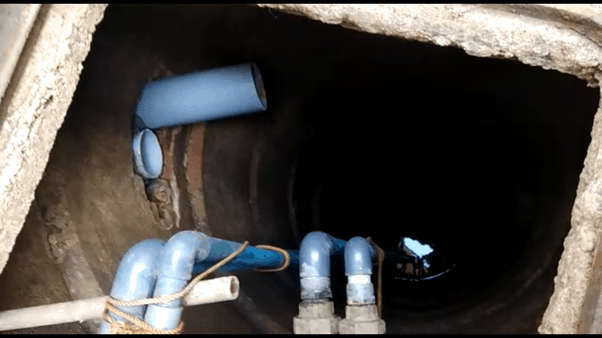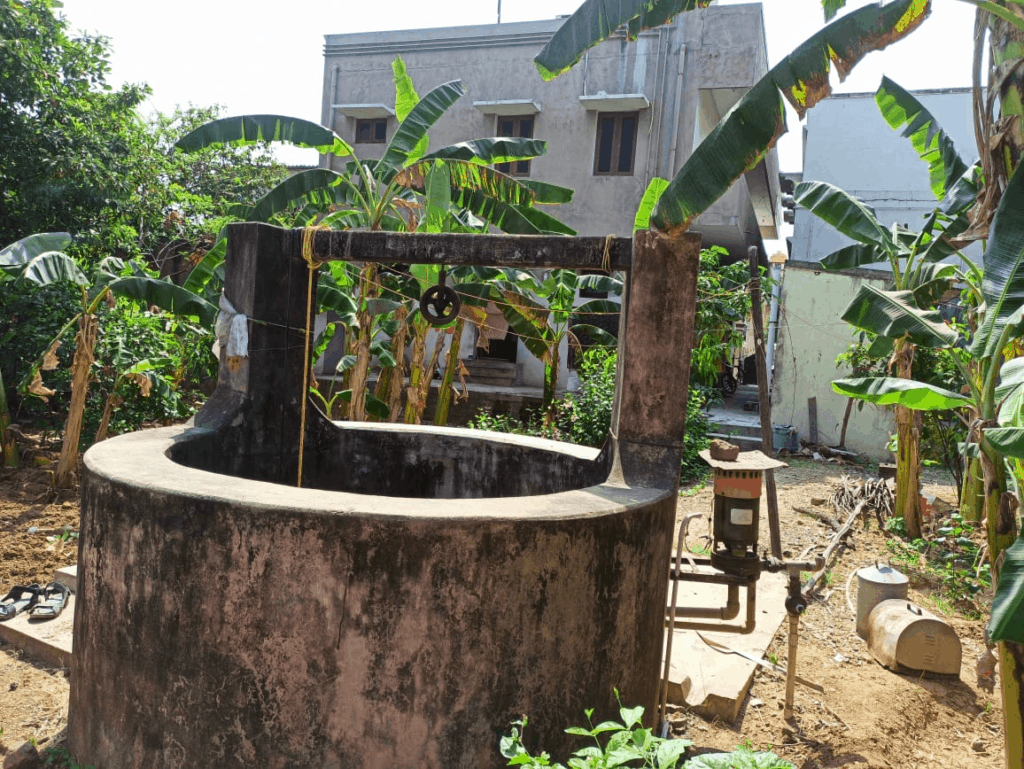The very approach of summer sends a few shivers down Chennai’s spine now. The memory of 2019 is still fresh and enough to bring on a few nightmares. Two deficit monsoons following the 2015 December deluge led to reservoirs going bone-dry, and the city literally running out of water. After Cape Town, Chennai had become the next face of a water-starved dystopia in national and global headlines.
While various solutions have been attempted since then to prevent recurrence of a similar situation in the city, Murali Anand Apartments in Mandaveli has a simple, traditional solution to suggest which saw them successfully tide over the 2019 crisis: open wells.
“Our 70-year-old well has never dried up. We fetched water from the good old well even during the 2019 water scarcity,” beams N Ravichandran, former secretary of the welfare association.
Open wells have in fact helped many residents to avoid water scarcity in Chennai. In the parched summer of 2019, Avinash, a resident of Perungalathur, did not have to rely on any private water source. Five decades ago, his grandfather had constructed a traditional brick-lined open well that still meets the water needs of the household, as well as the small agricultural patch of land adjacent to his house.
Being a coastal city, Chennai is also geologically most suited for open wells, says J Saravanan, a hydro-geologist. “For a city like Chennai where the alluvial soil of Adyar and Cooum rivers are deposited all over the central part of Chennai up to a depth of 20 metres, open wells are ideal. Whenever it rains, the alluvium quickly absorbs the rainwater,” says Saravanan.
How do these open wells currently fare in this city, that has grown exponentially over the past several decades?
Read more: ‘Water deposit’ revives open wells
Open wells in history
In general, groundwater extraction can occur in two ways — through borewells and open wells. Open wells are the most basic type of well, formed by drilling a hole in the ground, through which the groundwater from the shallow aquifer is extracted. On the contrary, borewells extract water from the deeper aquifers.
Open wells are more sustainable as the shallow aquifers are replenished soon after every monsoon season. Localities such as Perungudi, Karapakkam, Porur, Anna Nagar and Royapuram are ideal for having open wells.
Historically, Chennai was dependent primarily on the water stored in lakes, ponds and tanks, and a few open wells, for everyday water consumption until the 1960s. Over time as the surface water resources such as ponds, lakes, etc. started drying up, the city started depending more heavily on ground water starting with open wells.
In the book, Ways and Works in India: Being an Account of the Public Works in that Country from the Earliest Times Up to the Present Day, author George Walter Macgeorge has documented the water management system of the then Madras. According to the author, in 1772, the project to construct ten open wells began in George Town. Of which, three wells were abandoned due to poor yield. The seven wells supplied water to the entire city and did not show any signs of failure while it was in operation.
Architect planner Thirupurasundari Sevvel points out that the presence of temple ponds in the present day context is sufficient to explain the traditional water conservation system. Some of the popular temple tanks in the city are: Kapaleeswarar temple tank, Parthasarathy temple tank and Marundeeswarar temple tank.
“The stories of open wells, community wells and temple tanks should be spoken about widely to understand how the historic technique is relevant even today in urbanised cities. This is important to break the myth that open wells are outdated,” she states.
Importance of open wells
With time and increase in built up areas, the focus has almost entirely shifted to borewells. “In the mid 1960s, the first drilling rig was imported from the Netherlands for digging borewells. As borewells became popular, open wells became redundant,” says Saravanan. Today, in addition to the water supplied by the Metrowater agency, people in Chennai largely rely on borewells, that are plenty and easy to find across the city.
But those who have open wells in their homes till vouch for their usefulness. “In 2019, we drew water from the well which was sufficient to meet our everyday needs though water was not upto the brim. The well has never gone bone-dry. The quality of water is also better than what the local body supplies us,” says Avinash of Perungalathur.
With the presence of Retteri and Porur lake in the vicinity, Pugalaventhan V’s 25-year-old open well at his Porur home gives him water all through the year. “The water bodies recharge the well. Since our locality falls under the limits of the Chennai Corporation, we use the well water as a secondary water source,” Pugal adds.
Although exact data on the number of functional wells and their yields are unavailable, the presence of unused wells that are decades old highlight that the city had plenty of open wells in the past, before the adoption of newer techniques for accessing water. People were self-sufficient as almost all households had open wells. Sekhar Raghavan, Director, Rain Centre (a not-for-profit organisation that works on water resources and conservation) feels that open wells should be popularised as a supplementary source to be used when the municipal supply falls short or when the borewell water quality is of poor quality.
Read more: Where does the water in your tap come from?
What advantage do open wells have over borewells?
Both Sekhar and Saravanan aver that the shallow aquifers get replenished quickly and easily during the monsoon season. Unfortunately, however, current practice sees much larger amounts of groundwater being exploited through borewells dug to greater depths. Indiscriminate exploitation of groundwater thus has rendered many borewells dry either seasonally or completely in several parts of the city.
The water quality in the shallow aquifer is fresh and free from organic compounds or contaminants. Sekhar states that water from an open well will certainly be better in quality than that obtained through borewells, even if it is lower in volume. “In water, the principle is, water of a better quality will always float [shallow aquifer] while heavier water with more salt content will settle at the bottom [deeper aquifer],” he adds.
Thus drilling borewells to greater depths also results in the presence of higher concentration of hazardous chemicals such as fluorides, arsenic and nitrates in the water obtained through those.
Read more: Chennai has lessons to learn from its history of water mismanagement
Current status of open wells
Instances of people still using the traditional method of drawing water from open wells are few and far between. Thirupurasundari states that Chennai lost many of its open wells when old structures were replaced by multi-storey buildings. “In some cases, we lost open wells to lack of awareness. When it goes dry, residents demolish them or they just languish in neglect,” she adds.
“People still do not have faith in open wells and believe that borewells yield more water. Recently, I visited a complex close to Padur where a builder had closed five out of the six open wells within the property, before flat buyers prevented him from closing the sixth one. The builder is looking at open wells as something that occupies useful space which could otherwise be converted into another house or villa,” says Sekhar.
How can this be prevented? During 2013-2015, Rain Centre’s Akash Ganga Trust was asked by the state government to carry out an audit of RWH compliance and impact in Chennai Metropolitan Area. One of the recommendations of the report was to make it mandatory for builders to retain an open well if there was one in the plot, or create an open well where there was none. However, Sekhar adds that the government agencies have not made any concrete efforts to protect and revive open wells in the city.
Experts say that reviving open wells does not involve complicated procedures. “All it needs is desilting,” says Saravanan. The general perception among people is that when an open well goes dry, it marks the death of that well. They simply switch over to borewells. “But that is now how these wells work; we need to wait till the monsoon for the wells to get recharged. People should understand this mechanism,” Saravanan adds.
Also read:


We hv 2 open wells & that too built with special well smaller bricks. These 2 are over 30 yrs old & we maintain it well by cleaning, white wash on top few feets, desilting etc. A decade back, we commenced rain water harvesting with proper distillation process & we never faced water crisis & also quality of water is too good. We are just 3 kms fm Porur lake & presume this also help Ayypanthangal area opp. bus depot.
Hats off to you. Please advice the TN Government to revive the wells. Thank you.